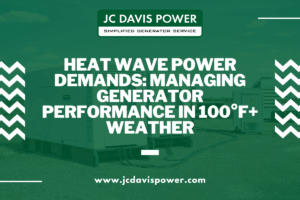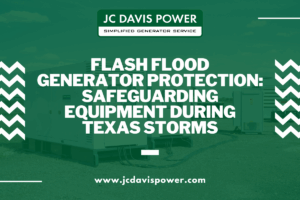Key Takeaways
- High temperatures reduce power output – Generators lose 10% power for every 18°F increase above 104°F
- Load management prevents failures – Running generators at 80% capacity helps avoid overheating damage
- Cooling is critical – Proper airflow and shade can extend generator life by years
- Fuel degrades faster – High heat breaks down diesel fuel quickly, causing performance issues
- Regular checks save money – Daily monitoring prevents costly breakdowns during heat waves
- Professional maintenance matters – Expert service keeps backup power reliable when you need it most
- Texas heat is brutal – Summer temperatures stress every generator component
When Texas heat hits 100°F+, your generator faces its biggest test. High temperatures above 104°F force you to reduce power output significantly.
This Article shows you how to keep your backup power running when the heat wave hits.
You’ll learn cooling tricks, load management, and maintenance steps that work.
How Do I Keep My Generator From Overheating in Extreme Heat?
Start with proper placement and airflow management.
Never run your generator in direct sunlight during a Texas heat wave. Set up a shade structure or move it to a covered area that still allows airflow.
Keep at least 5 feet of clearance on all sides. Hot air needs somewhere to go.
Load management saves your generator:
- Run at 80% capacity max during extreme heat
- Turn off non-essential appliances first
- Use a load bank to test capacity safely
- Monitor temperature gauges constantly
Check your cooling system daily. High temperatures stress cooling systems more than any other component.
Clean debris from air intake screens every morning. Dust and cottonwood seeds clog airflow fast in Texas.
Replace air filters more often during heat waves. A dirty filter makes your engine work harder and run hotter.
Can High Temperatures Affect Generator Performance in Texas?
Absolutely. Texas heat destroys generator performance in multiple ways.
Power output decreases by 10% for every 18°F increase above 104°F. A 120°F day cuts your generator’s power by nearly 10%.
Heat damages these critical systems:
- Engine components overheat and wear faster
- Electrical insulation breaks down quicker
- Fuel degrades and clogs injectors
- Batteries drain 50% faster in extreme heat
- Oil loses lubricating properties
High ambient temperatures increase wear and tear on every moving part. Your generator ages faster during heat waves.
Diesel fuel breaks down quickly in hot tanks. Bad fuel causes rough running and expensive repairs.
If you’re in Dallas, Austin, or San Antonio, you know how brutal summer heat gets. Your generator needs help to survive it.
Professional generator service in Austin, Dallas, or San Antonio can prevent most heat-related failures.
What Maintenance Is Needed for Generators During Heat Waves?
Daily checks become critical when temperatures soar above 100°F.
Morning routine (before starting):
- Check coolant levels and look for leaks
- Inspect air filter condition
- Test battery voltage (should be 12.6V+)
- Verify fuel quality and levels
- Clear debris from air intakes
Running checks (every 2-4 hours):
- Monitor engine temperature constantly
- Watch for unusual sounds or vibrations
- Check oil pressure readings
- Verify cooling fan operation
Change oil more frequently during heat waves. High temperatures reduce lubrication efficiency and break down oil faster.
Use synthetic oil if possible. It handles heat better than conventional oil.
Weekly heat wave maintenance:
- Replace air filter if dirty
- Clean cooling fins and heat exchangers
- Test automatic shutdown systems
- Check belt tension and condition
- Inspect fuel lines for heat damage
Professional maintenance becomes essential during extended heat waves. Generator rental services often include maintenance support.
| Check | Frequency | Why It Matters |
|---|---|---|
| Coolant level | Daily | Prevents overheating |
| Air filter | Every 3 days | Maintains airflow |
| Oil level | Daily | Protects engine parts |
| Fuel quality | Weekly | Prevents injector clogs |
How Can I Extend Generator Life During 100°F+ Weather?
Smart operation and proactive care make the difference.
Never push your generator to 100% capacity during extreme heat. The extra stress causes internal components to overheat and reduces equipment lifespan significantly.
Run your generator during cooler parts of the day when possible. Early morning and late evening operation puts less stress on components.
Install these heat-fighting upgrades:
- Auxiliary cooling fans for extra airflow
- Insulated fuel tanks to prevent fuel degradation
- Remote monitoring systems for temperature alerts
- Automatic load shedding controls
Keep spare parts on hand during heat waves. Belts, filters, and fuses fail more often in extreme heat.
Use fuel additives designed for high temperatures. They prevent gel formation and injector clogs.
Consider generator rental for backup during maintenance. You can’t afford downtime during a Texas heat wave.
Professional support saves money long-term. Expert technicians spot heat-related problems before they cause expensive failures.
Regular professional maintenance costs far less than emergency repairs during a power outage.
What This Means for You
Texas heat waves test every generator to its limits. Smart operation and regular maintenance keep your backup power reliable when you need it most.
Start with proper placement, manage your electrical load, and check your generator daily during extreme heat.
Don’t wait for problems to start. Contact professional generator services before the next heat wave hits your area.





